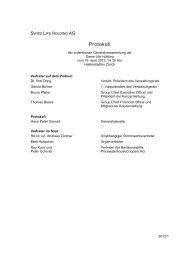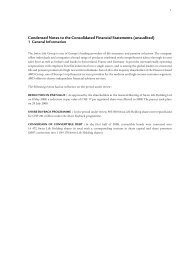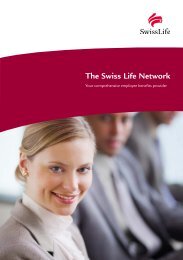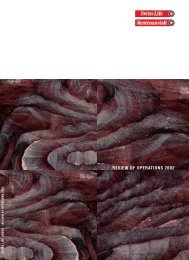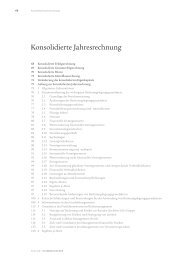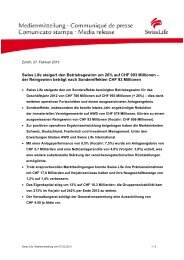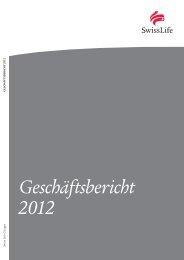Annual Report 2012 - Swiss Life
Annual Report 2012 - Swiss Life
Annual Report 2012 - Swiss Life
You also want an ePaper? Increase the reach of your titles
YUMPU automatically turns print PDFs into web optimized ePapers that Google loves.
114 Consolidated Financial Statements<br />
is measured using the fair value model in IAS 40 Investment Property. The amendment provides<br />
a practical solution to the problem by introducing a presumption that recovery of the carrying<br />
amount will normally be through sale. The amendment applies to annual periods beginning on or<br />
after 1 January <strong>2012</strong>. These amendments currently have no impact on the Group’s consolidated<br />
financial statements.<br />
In October 2010, amendments to IFRS 7 Financial Instruments: Disclosures were issued. The amendments<br />
will allow users of financial statements to improve their understanding of transfer transactions<br />
of financial assets (for example securitisations), including understanding the possible effects of<br />
any risks that may remain with the entity that transferred the assets. The amendments also require<br />
additional disclosures if a disproportionate amount of transfer transactions are undertaken around<br />
the end of a reporting period. The amendments apply to annual periods beginning on or after<br />
1 July 2011. The <strong>Swiss</strong> <strong>Life</strong> Group is currently not impacted by these amendments.<br />
The following amended Standards and Interpretations are not relevant to the <strong>Swiss</strong> <strong>Life</strong> Group:<br />
– Amendments to IFRS 1 First-time Adoption of International Financial <strong>Report</strong>ing Standards<br />
2.3 Consolidation principles<br />
The Group’s consolidated financial statements include the assets, liabilities, income and expenses of<br />
<strong>Swiss</strong> <strong>Life</strong> Holding and its subsidiaries. A subsidiary is an entity in which <strong>Swiss</strong> <strong>Life</strong> Holding owns<br />
directly or indirectly more than 50% of the voting rights, or in which it otherwise has the power to<br />
exercise control over operations. Subsidiaries are consolidated from the date on which effective control<br />
is obtained. All intercompany balances, transactions and unrealised gains and losses on such transactions<br />
have been eliminated. A listing of the Group’s subsidiaries is set out in note 37. The financial<br />
effect of acquisitions and disposals of subsidiaries is shown in note 29. Associates for which the<br />
Group has between 20% and 50% of the voting rights and/or exercises significant influence are<br />
accounted for using the equity method. The Group’s share of net income for the year is recognised as<br />
a share of profit or loss of associates and the ownership interest in the investment is recorded in the<br />
balance sheet at an amount that reflects its share of the net assets. The Group’s share of net income is<br />
included from the date on which significant influence begins until the date on which significant<br />
influence ceases. Unrealised gains arising from transactions with associates are eliminated to the<br />
extent of the Group’s interest. Unrealised losses are eliminated unless the transaction provides evidence<br />
of an impairment of the asset transferred. The carrying amount includes goodwill on the acquisition.<br />
A listing of the Group’s principal associates is shown in note 16.<br />
Non-controlling interest is the part of profit or loss and net assets of a subsidiary attributable to<br />
equity interest that is not owned, directly or indirectly, through subsidiaries by the parent. The<br />
amount of non-controlling interest comprises the proportion of the net fair value of the identifiable<br />
assets, liabilities and contingent liabilities not attribut able, directly or indirectly, to the parent at the<br />
date of the original acquisition, goodwill attributable to non-controlling interest, if any, and the proportion<br />
of changes in equity not attributable, directly or indirectly, to the parent since the date of<br />
acquisition.<br />
2.4 Foreign currency translation and transactions<br />
Functional and presentation currency<br />
Items included in the financial statements of the Group are measured using the currency of the primary<br />
economic environment in which the Group’s entities operate (the “functional currency”). The con-<br />
<strong>Swiss</strong> <strong>Life</strong> – <strong>Annual</strong> <strong>Report</strong> <strong>2012</strong>



